One of the most interesting features of TTDX is the signalling. In many other railroad games, signals are simply lacking, instead trains randomly choose where to go and if two trains get on the same track they can just go through each other without being damaged. In TTDX, placing signals correctly is almost as important as building the track in the first place. Without signals, one cannot build complex railway networks, which are essential for high profit.
Building signals
Signals are built using the appropriate tool from the menu. At the first click, the signal will be built, clicking this signal again while using the signal building tool changes the direction. After placing the actual signal, one can change the signal type using the graphical interface.
By default, only two signal types (each as semaphores and light signals) are visible in the menu. This is totally fine, as the other signal types are more or less obsolete. They only remain for historic reasons and to maintain backwards compatibility with the original TTDX. Basically all signalling tasks can be solved by these two types.
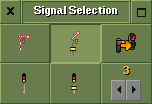
The signal menu opens as you select the signal icon from the tool bar. The signal type can be selected from this window, with the upper row showing the semaphore versions, the lower row showing the light signals. Both semaphores and light signals act identically.
When activating the option to show all signal types in the menu, the number of types increases considerably. As mentioned, these are not needed by most players, nevertheless they should at least be mentioned here.
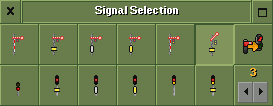
The full menu shows four additional signal types. The leftmost basic signal was already present in the original Transport Tycoon in 1993, the other types were later introduced by TTDPatch and taken over in OpenTTD.
Terms and descriptions
To understand the theories in the following paragraphs, it is necessary to know some terms:
- signal block
- A signal block consists of all pieces of track between entry signals and exit signals. There can be up to 255 signals for a signal block, which should be more than enough. There can also be blocks without entry/exit signals, so that trains cannot enter/leave the block, but these setups do not any have practical relevance.
- entry/exit signal
- Entry signals are all signals that lead into a signal block, exit signals lead out of the block (this is not about the type of signal, just about the fact whether the signal is at the beginning or the end of the block).
Exit from one block means entry into the next block. That means a signal is an entry and an exit signal at the same type, depending on the block in question.
In case this was too complicated and theoretical, an example from road traffic may help: A signal block can be compared to a busy intersection. On each side there are traffic lights that manage who may enter the intersection, so that crashes are avoided. One may only enter the intersection by passing a green traffic light (so the traffic light can be seen as the entry signal for a signal block). Now one may continue down the road up to the next traffic light. There one leaves the block, the second traffic light acts as exit signal for that section.
Signals divide the rail network into disjoint sections (signal blocks), which ensures that all trains have sections reserved exclusively for themselves in order to avoid crashes. These signal blocks may be several miles long in the real world. This length is linked to the braking distances of the trains, which can easily reach a mile or more, depending on the weight and speed of the trains.
Examples
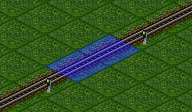
This is a very simple signal block. The signal to the left leads into it, the other one leads out. The tracks to the left and right of that block form additional signal blocks.
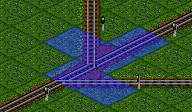
Here, one track branches into three. This is the common case at junctions, where signalling becomes important.
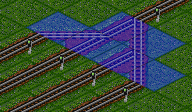
The inverse is also possible, four tracks merge into one here. In such a case signals are vital for directing traffic.
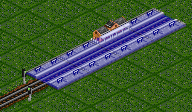
A signal block does not have to consist of just railway tracks. Here the station forms one signal block, guarded by a two-way signal to allow entry and exit.
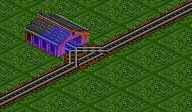
Depots are a special case, as they have a built-in invisible signal. Therefore the rails in front of the depot are a different signal block than the depot itself.
Behavior
Signal aspects
In TTDX, a signal can either show "Stop!" or "Go!". This is true for all signal types, also for presignals and path-based signalling! Both enhancements only change the conditions that determine whether a signal should switch between the two states. A light signal shows its state by a green or red light. Semaphores raise or lower their arms.

Example for semaphores and light signals, each showing "Go!" (left) and "Stop!" (right).
Passing a signal
A train will never, under no circumstances cross a red signal (the player may enforce it manually, though). It will either try to find another way, or it will stop at the signal, waiting for it to turn green. Whether a signal can be passed from the wrong side depends on the signal type (this is described in detail on the corresponding section describing the signal type). If a signal has not turned green after a certain amount of time, a train waiting there will turn around and try to find another way. The waiting time can be set (which should not be necessary in general, the presets should be fine).
Pathfinding
Before discussing the influence of signals on the behavior of trains it is important to take a short look at their pathfinding. Think of a moving train as the result of two processes: pathfinding tells the train where to go, and the signals tell the train when to go. Usually, both processes are connected in various ways, i.e. as soon as you build junctions and signals a train will not move without the results of both processes.
OpenTTD/JGR's patch pack
OpenTTD uses a completely rewritten algorithm called YAPF (yet another path finder). This algorithm can look for paths through the network much more cleverly than the original one, so the limitations from the original engine (as described in the section for TTDPatch) do not matter anymore. In addition, the new system is much more flexible.
As players, you only need to know that the pathfinding also takes signals into account when calculating the best route. Each possible path will be given a certain value, depending (upon other criteria) on the number of signals which show "Stop!". The path with the best value is then chosen.
